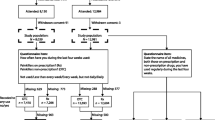Abstract
Pain is a significant health problem, and there is considerable need for clinical and epidemiological research in this topic. A prerequisite for doing research on patients treated with strong analgesics is that it is possible to identify the patients. We assessed two Danish population-based information systems, in which patients treated with strong analgesics are registered by using the patients' personal registration numbers as identifier. The two systems, which we compared, were (1) a surveillance system administered by the National Board of Health, and (2) the drug presciption register in the Danish National Health Service. During August 1994, 3787 patients were registered in the surveillance system and 3812 in the National Health Service in North Jutland County. Ninety-five persons were registered only in the surveillance system, and 120 only in the National Health Service register. A capture-recapture analysis showed a coverage of 96.9% for the surveillance system and 97.5% for the National Health Service. We thus conclude that the two systems form a valuable study base of patients treated with strong analgesics in epidemiological research.
Similar content being viewed by others
References
Frølund, F., and Frølund, C., Pain in general practice.Scand. J. Prim. Health Care 4:97–100, 1986.
Baker, J. W., and Morskey, H., Pain in general practice.J. Psychosom. Res. 10:383–387, 1967.
Andersen, S., and Worm-Pedersen, J., The prevalence of persistent pain in a Danish population. In Proc. 5t World Congress on Pain.Pain (suppl.) 4:332, 1987.
Brattberg, G., Thorslund, M., and Wikman, A., The prevalence of pain in a general population. The results of a postal survey in a county of Sweden.Pain 37:215–222, 1989.
Report of the International Narcotics Surveillance Board. Demand for and supply of opiates for medical and scientific needs.Geneva: WHO, 1981–1990
Ahonen, R., Enbund, H., Klankha, T., and Martikainen, J., Consumption of analgesics and anti-inflammatory drugs in the Nordic countries between 1978–1988.Eur. J. Clin. Pharmacol. 41:37–42, 1991.
Sørensen, H. T., Rasmussen, H. H., Ejlersen, E., Møller-Petersen, J., Hamburger, H., and Olesen, F., Epidemiology of pain requiring strong analgesics in a defined population outside hospitals in Denmark.Dan. Med. Bull. 39:464–467, 1992.
Sørensen, H. T., Ejlersen, E., Rasmussen, H. H., Møller-Petersen, J., Hamburger, H., and Olesen, F., One year follow-up after first prescription of strong analgesics.Int. J. Risk Safety Med. 4:209–213, 1994.
Sørensen, H. T., and Larsen, B. O., A population-based Danish data resource with possible high validity in pharmacoepidemiological research.J. Med. Systems 18:33–38, 1994.
Sørensen, H. T., Steffensen, F., Ejlersen, E., Møller-Petersen, J., and Kristensen, K., Research in the Danish Health Service system: Completeness and validity of prescription data, illustrated by utilization of oral anticoagulants.Int. J. Risk Safety Med. 7:33–41, 1995.
The Danish Medical Association. Medicinfortegnelse 1994 (Directory of drugs in Denmark).Lægeforeningsforlag, Copenhangen, pp. 509–515, 1994.
Sørensen, H. T.,Epidemiology in Health Care Research and Planning. A Review with Special Reference to the Danish Health System and Existing Information Systems. Aalborg University Press, Aalborg, 1994.
Sørensen, H. T., Re: compendium in public health data sources.Am. J. Epidemiol. 135:325–326, 1992.
Bishop, Y. M. M., Fienberg, S. E., and Holland, P. W.,Discrete Multivariate Analysis: Theory and Practice. A: MIT Press, Cambridge, 1975.
Hook, E. B., and Regal, R. R., The value of capture-recapture methods even for apparent exhaustive surveys. The need for adjustment for source of ascertainment intersection in attempted complete prevalence studies.Am. J. Epidemiol. 135:1060–1067, 1992.
Sørensen, H. T., Sabroe, S., and Olsen, J., A framework for evaluation of secondary data sources for epidemiological research.Int. J. Epidemiol. Accepted for publication.
Eriksen, J., Clausen, T. G., and Borgbjerg, F. M., Opioide analgetika i behandlingen af kroniske smerter af ikke-cancer oprindelse (Opioid analgesics in the treatment of chronic, non-malignant pain).Ugeskr Laeger. 151:621–627, 1994.
Author information
Authors and Affiliations
Rights and permissions
About this article
Cite this article
Toft Sørensen, H., Hansen, I., Ejlersen, E. et al. Identification of patients treated with strong analgesics: An assessment of two Danish information systems with respect to epidemiological research. J Med Syst 20, 57–65 (1996). https://doi.org/10.1007/BF02260874
Issue Date:
DOI: https://doi.org/10.1007/BF02260874




